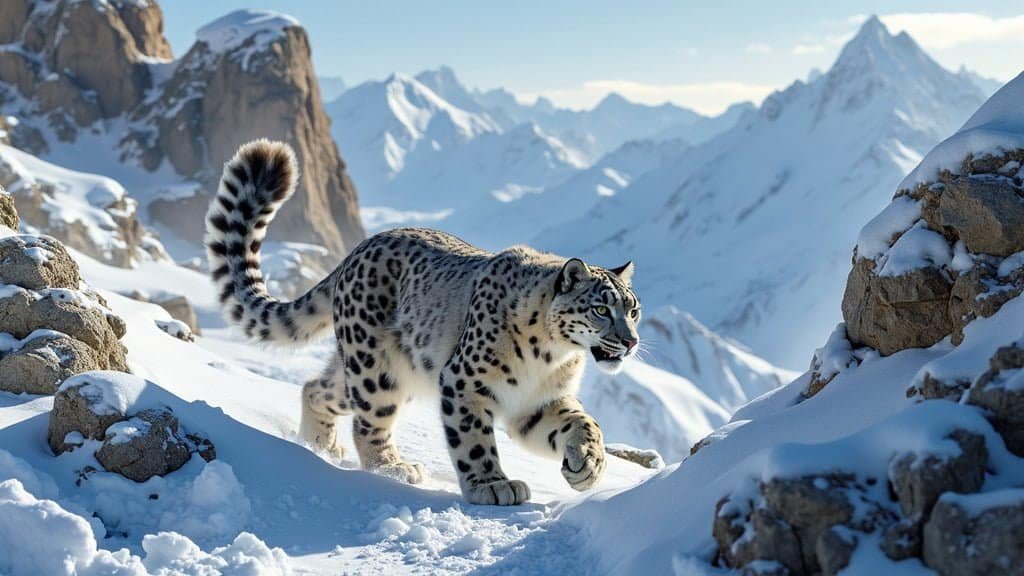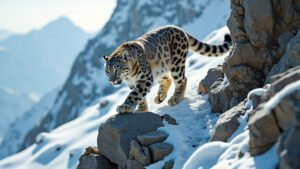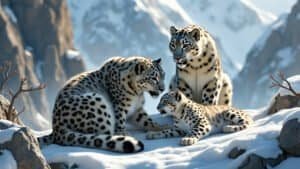Introduction
Snow leopards are elusive and majestic big cats that inhabit the high mountain ranges of Central and South Asia. Understanding their migration patterns is crucial for their conservation
This article explores the primary factors influencing snow leopard migration, including climate change, prey availability, human activities, and terrain features. Each section will delve into how these elements impact the movement and survival of snow leopards, providing a comprehensive overview of the challenges and adaptations faced by these magnificent creatures
Climate Change and Snow Leopard Migration
Climate change significantly impacts snow leopard migration patterns, affecting their habitat, prey availability, and overall survival. Rising temperatures, changes in snowfall, and ice melt are some of the critical factors driving these changes
Impact of Rising Temperatures
Rising temperatures in the snow leopard’s mountainous habitats have several profound effects. As global temperatures increase, the snow line—the boundary between snow-covered and snow-free areas—shifts upwards
This forces snow leopards to move to higher altitudes in search of suitable habitats. Research by the World Wildlife Fund (WWF) shows that these shifts can reduce the available habitat for snow leopards, leading to increased competition for space and resources
Higher temperatures also influence the vegetation in these regions, affecting the entire ecosystem. Plants that are crucial for the survival of the snow leopard’s prey may struggle to adapt to the warmer conditions, leading to a decrease in prey populations. This scarcity of food can force snow leopards to migrate more frequently and over longer distances to find sustenance
Changes in Snowfall and Ice Melt
Snowfall patterns are changing due to climate change, which directly affects the habitats of snow leopards. Reduced snowfall can lead to habitat loss, as areas that were once covered in snow and suitable for snow leopards become less so
Moreover, the timing and amount of snowfall are crucial for maintaining the balance of the ecosystems where snow leopards live. Altered snowfall patterns can disrupt this balance, affecting the availability of prey and the snow leopards’ ability to hunt
Ice melt is another significant factor. As glaciers and ice fields melt, the landscape changes, creating new challenges for snow leopards. These changes can make traditional migration routes impassable, forcing snow leopards to find new paths and potentially bringing them into closer contact with human populations, increasing the risk of conflict and poaching
Effects on Habitat Range
The combined effects of rising temperatures and changes in snowfall and ice melt lead to significant shifts in the habitat range of snow leopards
Studies have shown that suitable habitats for snow leopards are shrinking, pushing them into smaller, more fragmented areas. This fragmentation makes it difficult for snow leopards to find mates and maintain healthy genetic diversity, which is crucial for the long-term survival of the species
Moreover, as snow leopards are forced into higher altitudes, they encounter harsher conditions and fewer resources. These new habitats may not provide the same level of prey availability or shelter, making survival even more challenging. Adaptation to these new conditions requires energy and resources, further straining the snow leopards
Prey Availability and Snow Leopard Migration
Prey availability is a critical factor influencing snow leopard migration patterns. Snow leopards rely on specific prey species for their diet, and any changes in the populations or distribution of these prey animals can have a significant impact on snow leopard movements
Primary Prey Species
Snow leopards primarily hunt medium-sized mammals, with blue sheep (bharal) and ibex being their most common prey in many regions. Other prey includes marmots, pikas, hares, and occasionally livestock
The abundance and distribution of these prey species directly affect where snow leopards can live and hunt. For instance, a decline in blue sheep populations in certain areas can force snow leopards to migrate to other regions where prey is more plentiful
The availability of prey is influenced by various factors, including climate change, human activities, and natural population cycles. Conservation efforts often focus on ensuring the health of prey populations, as this is crucial for the survival of snow leopards
Seasonal Variations in Prey
Seasonal changes significantly affect prey availability and, consequently, snow leopard migration
During winter, prey animals may move to lower altitudes where food is more accessible, and snow leopards often follow these movements. Conversely, in the summer, prey animals move to higher elevations to graze, prompting snow leopards to migrate to these areas as well
This seasonal migration requires snow leopards to be highly adaptable and capable of covering large distances. The availability of prey during different seasons can also affect the reproductive success of snow leopards, as females need sufficient food resources to raise their cubs successfully
Impact of Prey Scarcity
When prey becomes scarce, snow leopards are forced to expand their range in search of food. This increased movement can lead to conflicts with other predators, such as wolves and lynx, who may also be competing for the same prey
Additionally, prey scarcity can drive snow leopards closer to human settlements, increasing the likelihood of livestock predation and subsequent human-wildlife conflicts
Studies have shown that in areas where natural prey is limited, snow leopards may turn to domestic livestock for sustenance. This not only brings them into conflict with humans but also poses significant risks to their survival, as retaliatory killings by herders are a common threat
Human Activities and Snow Leopard Migration
Human activities have a profound impact on snow leopard migration patterns. Habitat fragmentation, poaching, illegal trade, and human-wildlife conflicts are significant factors driving these changes
Habitat Fragmentation
Habitat fragmentation is one of the most significant threats to snow leopards. Infrastructure development, such as roads, mining, and human settlements, divides the snow leopard’s habitat into smaller, isolated patches
This fragmentation limits the space available for snow leopards to roam and hunt, forcing them to migrate more frequently and over longer distances to find suitable habitats
Fragmented habitats also reduce the likelihood of snow leopards encountering mates, leading to inbreeding and decreased genetic diversity. A study published in the journal “Biological Conservation” highlights that fragmented landscapes significantly hinder the movement and gene flow of snow leopards, increasing the risk of local extinctions (Riordan et al., 2016)
Poaching and Illegal Trade
Poaching and illegal wildlife trade pose severe threats to snow leopard populations
Snow leopards are targeted for their fur, bones, and other body parts, which are highly valued in illegal markets. The International Union for Conservation of Nature (IUCN) estimates that hundreds of snow leopards are killed each year due to poaching (IUCN, 2020)
The fear of poaching forces snow leopards to migrate to less accessible areas where they are less likely to be targeted by humans. This migration can lead to increased competition for limited resources and higher mortality rates
Conservation organizations are working to combat poaching through anti-poaching patrols, community education, and strengthening wildlife protection laws
Human-Wildlife Conflict
Human-wildlife conflict is another significant factor influencing snow leopard migration. As human populations expand into snow leopard habitats, conflicts over resources become more common
Snow leopards may prey on livestock, leading to retaliatory killings by herders. These conflicts not only reduce snow leopard numbers but also disrupt their natural migration patterns
Efforts to mitigate human-wildlife conflict include the development of predator-proof livestock pens, compensation schemes for herders who lose livestock to snow leopards, and community-based conservation programs. These initiatives aim to foster coexistence between humans and snow leopards, reducing the need for the animals to migrate in search of safer territories
Terrain Features and Snow Leopard Migration
The terrain in which snow leopards live plays a crucial role in shaping their migration patterns. Mountainous landscapes, natural barriers, and preferred migration corridors all influence how these big cats move across their habitat
Mountainous Landscapes
Snow leopards are typically found in rugged, mountainous regions of Central and South Asia, including the Himalayas, the Tian Shan, and the Altai mountains
These landscapes provide the rocky outcrops and steep terrain that snow leopards prefer for hunting and shelter. The complexity of these landscapes creates natural pathways and obstacles that direct the movement of snow leopards
Mountainous regions also offer various microhabitats, from alpine meadows to coniferous forests, which support different prey species and influence snow leopard distribution. Seasonal changes in these landscapes, such as snow cover in winter and lush vegetation in summer, further drive the migration patterns of snow leopards as they follow prey to different elevations
Natural Barriers
Natural barriers like rivers, glaciers, and steep cliffs can significantly impact snow leopard migration
These features can either facilitate or hinder movement, depending on their location and size. For instance, a glacier might serve as a seasonal barrier that snow leopards must navigate around, while a river might be a consistent obstacle that defines the boundaries of a snow leopard’s territory
The presence of such barriers often requires snow leopards to develop specific routes and strategies to move through their habitat. These routes can become well-trodden paths over generations, with snow leopards passing knowledge of these pathways from one generation to the next
Preferred Migration Corridors
Snow leopards tend to use specific migration corridors that offer the least resistance and the most access to prey and water. These corridors are typically areas where the terrain is less rugged and more navigable
Understanding these preferred migration routes is essential for conservation efforts, as protecting these corridors can ensure that snow leopards have safe passage through their habitat
A study published in “Ecology and Evolution” (2021) used GPS collars to track snow leopard movements and identified critical migration corridors that cross national borders. Protecting these transboundary corridors requires international cooperation and a landscape-level approach to conservation
Conclusion
Understanding the factors influencing snow leopard migration patterns is essential for their conservation. Climate change, prey availability, human activities, and terrain features all play significant roles in shaping these patterns
Rising temperatures and changes in snowfall force snow leopards to seek new habitats, while the availability of prey determines where they can hunt and survive. Human activities such as habitat fragmentation, poaching, and human-wildlife conflict further disrupt their natural movements. The rugged mountainous landscapes and natural barriers of their habitats also guide their migration routes
Conservation efforts must address these factors by protecting habitats, ensuring prey populations, mitigating human-wildlife conflicts, and maintaining natural migration corridors. By understanding and addressing these influences, we can help ensure the survival and stability of snow leopard populations for future generations













